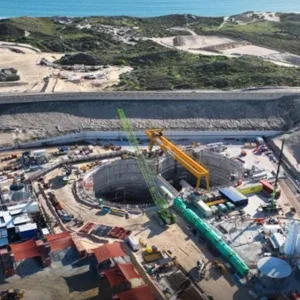The S1 main sewer interceptor project in Brisbane, Australia, is on schedule for a mid-2001 completion. Contractor joint venture, EO comprising Eroc (previously Peabody) and Obayashi completed the 4.6km tunnel late last year and is currently installing a self-designed and patented lining to comply with client Brisbane Water’s stringent design brief.
EOJV started work in July 1999 following award of the A$37M (US$20M) design and build project the month before. The 2.4m i.d tunnel runs at an average depth of 25m from North Quay to Kingford Smith Drive passing through 1km in soft ground and 3.6km in hard ground. The job was split into two separate TBM drives, working from a main shaft at Perry Park. One 1km drive began in April 2000 using a Lovat EPBM which completed boring in September. A Robbins TBM handled the 3.6km hard rock drive starting in February 2000 and finishing in October.
To comply with the brief for all exposed sewer concrete surfaces to be sealed with an impervious high density polyethylene or uPVC liner, Eroc is installing a patented uPVC liner that withstands external ground water pressure of up to 5 Bar.
The liners are manufactured off site into 2.4m diameter x 9m long tubes which are supported in the tunnel by modified concrete lining formwork. Sections up to 45m are concrete lined in one pour to a thickness of 300mm. The average weekly rate for lining is approximately 200m, with a best week reported of 300m.
The soft ground tunnel section has a precast segmental lining.
The corrosian-resistant liner is cast into a mortar grout and pumped into a 100mm (nominal) wide annulus between the uPVC and segments.
All the shafts, including the covers will be uPVC lined. The uPVC is cast in place with the concrete lining using various combinations of formwork.
The S1 main sewer interceptor project was designed by the Brisbane City Council. The city’s existing main sewer is over 75 years old and has reached capacity, and the new sewer is designed to overcome sewage overflows into the Brisbane River during heavy rainfalls.
A full feature on the project will appear in a forthcoming issue of T&TI.







